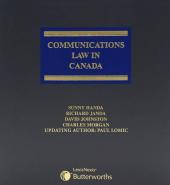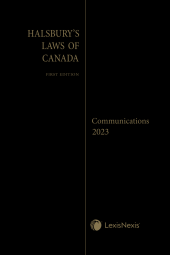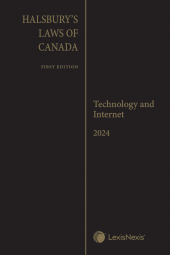E-mail Law
One Year Subscription Only Terms
Subscribers receive the product(s) listed on the Order Form and any Updates made available during the annual subscription period. Shipping and handling fees are not included in the annual price.
Subscribers are advised of the number of Updates that were made to the particular publication the prior year. The number of Updates may vary due to developments in the law and other publishing issues, but subscribers may use this as a rough estimate of future shipments. Subscribers may call Customer Support at 800-833-9844 for additional information.
Subscribers may cancel this subscription by: calling Customer Support at 800-833-9844; emailing customer.support@lexisnexis.com; or returning the invoice marked 'CANCEL'.
If subscribers cancel within 30 days after the product is ordered or received and return the product at their expense, then they will receive a full credit of the price for the annual subscription.
If subscribers cancel between 31 and 60 days after the invoice date and return the product at their expense, then they will receive a 5/6th credit of the price for the annual subscription. No credit will be given for cancellations more than 60 days after the invoice date. To receive any credit, subscriber must return all product(s) shipped during the year at their expense within the applicable cancellation period listed above.
Détails des produits
It is estimated that, during the second quarter of 2007, 196 billion e-mails circulated over the Internet every day and it is projected that this number will increase to 374 billion by 2011. You need to be aware of the legal impact of this kind of communication.
The fifth book in Butterworths Information Technology Law series; E-mail Law is an accessible, authoritative overview of the major legal ramifications of the commercial use of e-mail. It canvasses legislation from across Canada and the United States as well as relevant case law to provide readers with an up-to-date comprehensive Canadian perspective on e-mail legal issues and internet privacy law.
E-mail in a Commercial World - What You Need to KnowThis publication contains helpful material on topics such as e-contracts, spam, the monitoring of e-mail in an employment context and lawful access requests, document retention and the use of e-mail as evidence. You'll find a systematic analysis of current and upcoming trends as well as practical policy implementation advice for advisors in a variety of industries.
Well-written and Thorough, This Unique Reference Guide Provides- National coverage on trends in your own region as well as other provinces
- Policy implementation checklists with guidelines for setting up employment/commercial policies
- Expert commentary with concise, reliable advice for both lawyers and non-lawyers
- Efficiency of design featuring detailed subheadings that allow you to quickly find relevant material
- Corporate council - seeking a handy tool for creating employee e-mail use policies, advising on corporate document retention practices and providing information on valid e-mail contracting procedures
- Human resources professionals - looking to implement employee e-mail usage policies and monitoring programs
- Privacy/technology lawyers - when advising businesses on their e-commerce and electronic communication policies
Click here to read a review of this title
Table des matières
Foreword
Acknowledgments
Introduction
Chapter 1: Contract Formation via E-mail
I. Introduction
II. Legislative Framework
III - Offer and Acceptance
IV. Electronic Agents
V. Writing, Signature and Other Formalities
VI. Time and Place of E-mail Contract Formation
VII. E-mail Notices
VIII. Jurisdictional Issues
IX. Conclusion
Chapter 2: Spam
I. Introduction
II. Legislative Framework
III. Practical Steps Towards Controlling Spam
IV. Conclusion
Chapter 3: E-mail Monitoring
I. Introduction
II. Legislative Framework
III. E-mail Monitoring in the Employment Context
IV. Lawful Access and E-mail Monitoring
V. Conclusion
Chapter 4: Document Retention
I. Introduction
II. Legislative Framework
III. Statutory Retention Periods
IV. Document Retention Policy (DRP)
V. Sanctions for Unauthorized Retention and Destruction
VI. Conclusion
Chapter 5: E-mail as Evidence
I. Introduction
II. Legislative Framework
III. Admissibility
IV. Discovery of E-mail
V. Conclusion
 Lexis Nexis
Lexis Nexis 


